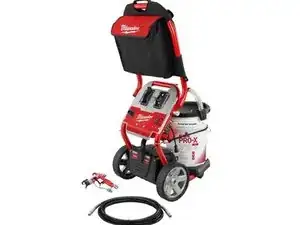Background
The Milwaukee M4910-21 paint sprayer was introduced in 2011 as the newest addition to the Milwaukee's power tools. Milwaukee Electric Tool Corporation, a subsidiary of Techtronic Industries Co. Ltd., is a leading manufacturer of heavy-duty power tools, hand tools, and accessories for professional users worldwide. This handheld sprayer delivers near to 3000 PSI (pounds per square inch) of pressure, generated by the 7-amp motor. This power allows for usability over various surfaces such as sealers, oil-based paints, and latex.
The Milwaukee M4910-21 was replaced by its successor the M4910-20 in 2016, which did not principally derive from the previous generation. The new model includes a longer hose and an improved motor for greater efficiency. Although the M4910-21 is unavailable for purchase through the Milwaukee website today, some units are still carried by third party sellers.
Identification
The Milwaukee M4910-21 includes a main body with a control panel mounted on a metal structure with two wheels. it also includes a spray gun and a hose which are detachable from the main body.
The physical specifications, according to amazon's webpage made by the manufacturer are :Length: 27 inches Width: 23 inches Height: 19 inches Weight: 41 pounds.
The handheld paint sprayer only comes in one color scheme of black with red accents. Primary visual characteristics for positive identification by users are the Milwaukee logo on the side and the the model number "M4910-21" on a plate attached to the motor housing.
Technical Specifications
- Power Source: Electric, 120V AC, 60Hz
- Motor: 0.5 horsepower (HP)
- Fluid Pressure: 800-3000 PSI (pounds per square inch)
- Flow Rate: 0.31 gallons per minute (GPM)
- Tank Volume: 5 Gallons
- Spray Patterns: Horizontal, vertical, and round
- Tip Size: 0.017 inches
- Hose Length: 50 feet
- Weight: 41 pounds
- Dimensions: 27 x 23 x 19 inches
- Sources:
- Milwaukee Operators Manual
